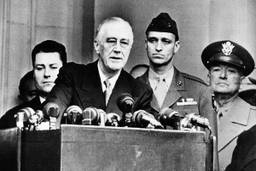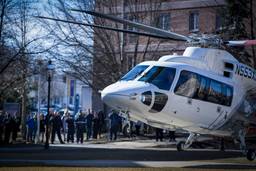Executioner-in-Chief
Obama’s drone attacks and the pathology of presidential power.
Elizabeth Sanders

It could have been worse. Had the November election gone differently, the United States could now be facing war with Iran, a budgetary tilt to expanded military spending offset by deeper cuts in domestic social and infrastructure programs, and a return to Bush-era unilateral militarism. However, it is easier to say what has probably been avoided than to predict what President Barack Obama’s renewed lease on the White House will mean in the next four years.
Prediction is always a tricky business, but the patterns of the past offer some guidance. New presidents are typically more war-prone than second-term presidents. There is a syndrome that might be called “novice macho,” whereby a new president, particularly one with no military experience, will order a military strike soon after taking office, to prove his mettle and warn adversaries not to take advantage.
After that, the period before the first midterm election, whose outcome is so important for the president’s prospects in the first term, is particularly likely to see the kind of military confrontation that scholars label “diversionary war,” designed to produce a rally effect for electoral advantage. Given this timing difference, and the fervent hawkishness of Mitt Romney’s foreign policy advisers, it is likely that fewer people will die under Obama than would have been the case under Romney. A little less war, a bit more prosperity, more business regulation, and additional help for the poor and the proverbial “middle class” under a reelected Obama: It could have been worse.
On the other hand, both candidates at the last presidential debate seemed to be in agreement on one aspect of American foreign policy: the use of unmanned drones to assassinate without judicial process people in other countries whom the CIA or military has decided are terrorists or dangerous “militants.” This is probably the area of greatest surprise and disappointment for those who supported Obama in 2008. Nothing in his previous personal or political life gave any hint that Obama could become such a cold-blooded selector of targets on a kill list, with little more hesitation than the occasional “Gosh, she looks pretty young. Are you sure she’s 17?”
No issue cuts more deeply into the American soul than the Obama administration’s enthusiastic embrace of “targeted” “extrajudicial” killing of suspected “terrorists” or “militants,” which often means simply “men with guns” or just “men looking suspicious.” The targeted individuals are often not far away from women and children collecting firewood at dawn, or at funerals, or people sleeping in their houses. The administration began, before the election, to draft a set of rules for drone killings, but new rules are unlikely to satisfy those who see the killings as stark violations of international law, as well as the U.S. Constitution.
The creation of moral hazards
Our founders, in their wisdom, set out to create a web of institutions in a republic so structured that ambition would check ambition and even “a race of devils” would behave well in its incentive structures. They were particularly determined not to vest in one ambitious executive the power to make war. The presidency is the founders’ major failure. The presidency is, I have come to believe in 30 years of researching and teaching about the office, a pathological institution. It provides too many incentives to begin and continue costly, unnecessary wars. It turns good men into killers without reflection or remorse.
Since World War II and the subsequent (presidentially constructed) Cold War, a massive military and intelligence complex — cloaked in secrecy, staffed by yes-men, able to act with great dispatch — has been at the president’s disposal to secure his own power and re-election by war-making. Between and during the big, lengthy, devastating wars in Korea, Vietnam, Afghanistan and Iraq, there have been hundreds of smaller ones. The toll from these wars in human suffering and death, ruined infrastructure and environmental devastation is almost incalculable.
And, as history has shown, in periods of war fatigue and financial exhaustion, the executive branch escalates its search for cheaper and more politically palatable air war technologies that minimize American losses on the ground.
The latest such weapon, embraced with such zeal by our current president, is the drone. Its appeal to presidents is obvious: it is unmanned, less costly than a manned bomber and terrifies the target population. The Bush administration initiated the use of CIA drone warfare in Afghanistan in November 2001. In early 2002, the CIA began to use drones without military support. Judging by John Sifton’s description in The Nation, the first such strike was a “pure CIA kill operation” of the type that came to be known as a “signature strike” based on observed characteristics — in this case, a small group of men, one of them tall. The tall man might have been Osama bin Laden. However, he was not. The three were all civilians, none affiliated with al Qaeda.
In the same year, the Bush administration extended drone attacks into another country, Yemen; two years later, drones were sent into Pakistan, destined to be the largest arena of drone attacks, and the site of the greatest number of “militant” and civilian casualties. A U.S. drone attacked al-Shabab militants in Somalia on June 23, 2011, according to the Washington Post, and drones were also used in NATO attacks in Libya in 2011. A secret military outpost in Burkina Faso is rumored to have sent drones against Islamists in northern Mali. The United States is thus increasingly becoming involved in civil conflicts in Africa and in assassinating Islamic militants who, as despicable as they may be, present no direct threat to the United States.
Counting drone deaths
By the end of 2008, the Bush administration had carried out (according to a New York Times analysis of data from the Long War Journal) 51 drone attacks in Pakistan, Yemen and Somalia. Obama has sharply escalated drone use, with an additional 294 strikes through May 2012. Though the administration for years has not admitted using drones outside the theater of war in Afghanistan, and long denied any civilian casualties, careful reports by the Long War Journal, the Bureau of Investigative Journalism, and a massive new report on drone deaths in Pakistan (“Living Under Drones,” a project of the Stanford and New York University law schools, published in September 2012) give the lie to those claims.
The Bureau of Investigative Journalism estimates that drone strikes killed between 2,500 and 3,300 people in Pakistan alone from June 2004 through September 2012, of whom 474 to 881 were civilians (including 176 children). Roughly 1,200 to 3,200 additional people were wounded. Current estimates for civilian deaths in Yemen and Somalia drone strikes range as high as 220. Only a small percentage of the drone killings were “high value targets.” Most were lower-level “militants” or civilians. Some of the deaths and injuries came in second-wave attacks against people who rushed to help the victims or who were subsequently mourning their deaths.
Obama’s major legacy may thus be the escalation of targeted killings of suspects with no judicial process, including at least two American citizens, and a large number of innocent civilians. The administration’s attempt to justify, with contorted legal arguments, the assassination of so many “suspected militants,” only loosely, if at all, linked to al Qaeda has undermined the reputation of the United States among allies and the world at large.
It is doubtful that the continued drone strikes contribute to U.S. security, and they may well be counterproductive. The thousands of deaths and injuries have fueled rage against the United States, marked by escalating violence in Yemen and elsewhere. In a New York Times op-ed, Ibrahim Mothana, a co-founder of the Watan Party of Afghanistan, quotes a Yemeni lawyer’s warning on Twitter last summer: “DEAR OBAMA, when a U.S. drone missile kills a child in Yemen, the father will go to war with you, guaranteed. Nothing to do with Al Qaeda.”
One can only hope that someone has given the president a copy of the Stanford/NYU report, with its heart-rending accounts of children blown to bits, devastated families, and enraged villagers. He cannot bring back the dead or offer much comfort to the grieving families. But he can do something to atone for his assaults on the fragile web of international law by stopping the drone strikes or at least greatly reducing them, offering compensation to survivors and finding ways to pursue peace in the region.
Such a policy transformation will require a massive popular campaign — a movement here and abroad to restore the international law that American activists (and a few past presidents) worked so hard to construct. There are no more serious assaults on the laws of war and human rights than those led by the president of the most powerful country on earth. If the United States can hunt down suspected militants and assassinate them from remote-controlled drones, other countries will perceive that they have the right to do so as well. Immanuel Kant’s categorical imperative, a more sophisticated and secular rendering of the Golden Rule, should be posted in the oval office: “Act in such a way that the principle according to which the action is performed can be accepted as a universal law.”
However unlikely that posting on a White House wall, it might make a good sign to carry in a march … or to send in a tweet.
SPECIAL DEAL: Subscribe to our award-winning print magazine, a publication Bernie Sanders calls "unapologetically on the side of social and economic justice," for just $1 an issue! That means you'll get 10 issues a year for $9.95.





